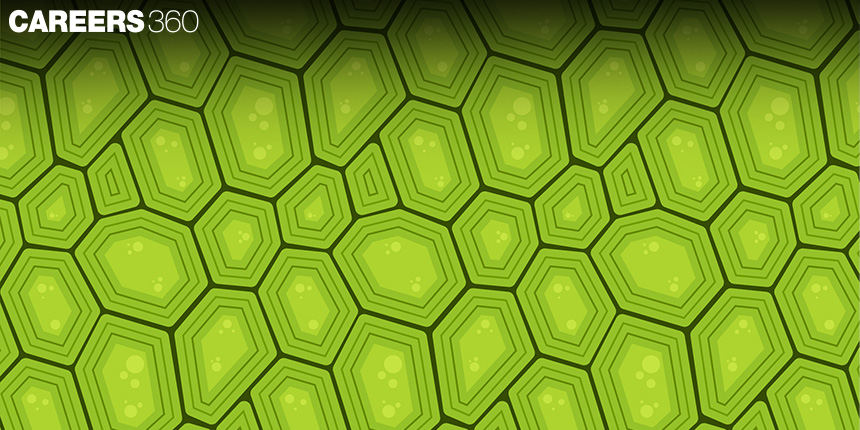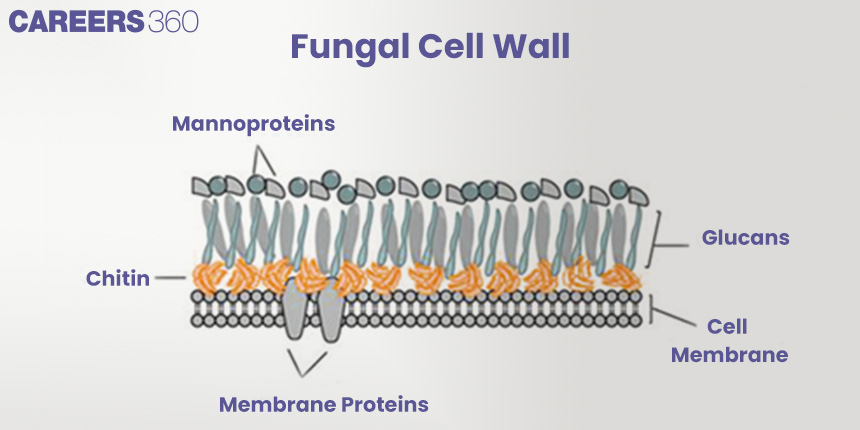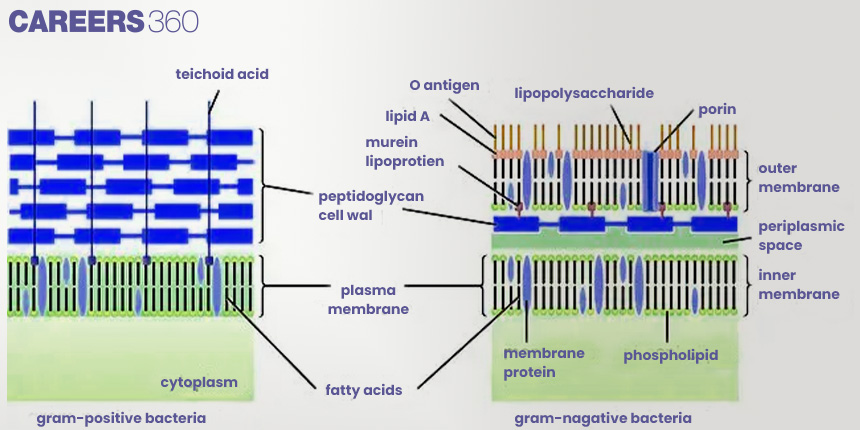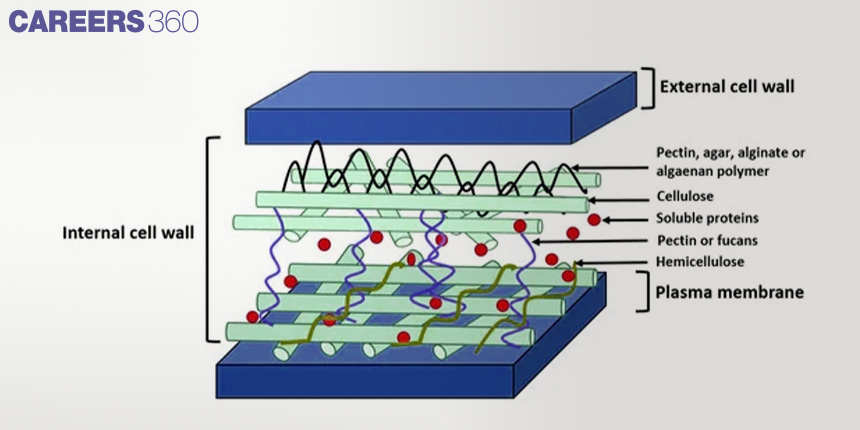Cell Wall
Cell wall definition: The cell wall is the outermost covering in plant cells, beyond the cell membrane. It protects the plasma membrane from shocks and other physical stress. The cell wall is the topic of the chapter Cell: The Unit of Life in Biology.
What is a Cell Wall?
The cell wall is a thick, string-shaped protective layer outside the cell membrane, giving the cell its shape and strength. This essential component is defined in composition differently in different organisms but it fulfils the same basic functions in those life forms. Due to the rigidity of the cell wall, it can also have the ability to support mechanical stress and cell integrity, which is very important for the cells that are exposed to different conditions.
NEET 2025: Mock Test Series | Syllabus | High Scoring Topics | PYQs
NEET Important PYQ's Subject wise: Physics | Chemistry | Biology
New: Meet Careers360 B.Tech/NEET Experts in your City | Book your Seat now
- What is a Cell Wall?
- Examples in Organisms
- Cell Wall Structure
- Types of Cell Walls
- Differences between Gram-positive and Gram-negative bacteria
- Functions of Cell Wall
- Biosynthesis of the Cell Wall
- Modifications and Adaptations
- Comparison with Animal Cells
- Recommended video on Cell Wall

Examples in Organisms
Some examples of the presence of cell walls in organisms are-
Plants
The plant cell’s structure comes from the cellulosic cell walls that also act as its protection.
Fungi
In fungal cells, the primary component of the cell wall is chitin and it provides the much-needed structural support and a shield to the cells while those of the plants have cellulose walls.
Bacteria
Indeed bacterial cell walls have a structural molecule known as peptidoglycan that maintains cell shape and rigidity of the wall the differences in peptidoglycan determine whether bacteria is Gram-positive or Gram-negative.
Protists
Most protists have different cell wall constitutions; some e. g. algae possess cellulose while certain others have no cell wall at all given their locality and differentiated roles.
Also Read-
Cell Wall Structure
It involves numerous biochemical components that help offer strength, rigidity, and functionality to the cell wall. The components in each of the organisms are not the same, although certain features are similar and enhance cell wall integrity and performance.
Basic Components
Polysaccharides (cellulose, hemicellulose, pectin)
Cellulose is present in the cell wall of plant cells and is a polymer of glucose, therefore, a carbohydrate in nature after the formation of long chains of manageable sizes through links. These chains create microfibrils that give flexibility to skin and tensile strength as well.
Hemicellulose is a great group of polysaccharides that are associated with cellulose fibers and enhance the structural properties, and flexibility of the cell wall.
Pectin consists of a galacturonic acid-high polymer that occurs in the principal layer of the cell wall and the middle lamella. Pectin has the function of being the gel-like structure that aids in adhesion and also plays a role in the cell wall’s water content.
Proteins
Glycoproteins like extensions, are proteins the role of which is to form cross-links with other features of the cell wall hence causing the wall to become stronger. Closely associated with the growth and development of cells by participating in the processes of remodeling and degradation of the cell wall.
Lignin (in certain plants)
An aromatic heteropolysaccharide located in the secondary cell wall of vascular plants. Lignin adds mechanical strength, prevents water absorption, and prevents infections leading to taller plants and survival in a variety of conditions.
Detailed Layer Structure
Primary cell wall
The plant cell wall is compartmentalised into different layers and is composed of different materials doing different jobs. Largely of cellulose, hemicellulose, and pectic substances.
Facilitates the growth of flexible and strong cells to the future growth of tissues. It is somewhat thin and also lets cells split and divide in this region.
Middle lamella
Rich in pectin. Serves the role of a cement for adjacent plant cells so that they can stick together tightly and also helps in their communication. It is the outermost layer of the newly formed cell.
Secondary cell wall
Has more cellulose and in vascular plants this is usually supported by lignin. Gives added strength and stability, particularly in the cells that have ceased to divide or are in the process of division. This forms after the cell has ceased division and it is essential in providing support to the structure of the plant.
Types of Cell Walls
The cell wall types are discussed below-
Plant Cell Walls
Cell walls are found in Plants that include cellulose, hemicellulose, and pectin. The cell wall of plant cells offers mechanical strength, protection, and even identity of the cell. They also govern the intake of water and nutrients and are involved in signal transduction across cells.
Primary vs. secondary cell walls
Able to swell and shrink and is made up of cellulose, hemicellulose, and pectin. Permits new cell synthesis and growth from a basic template, specific to the sources.
More rigid than the primary cell wall and usually contains, besides cellulose, lignin as well. Supports the cell walls of mature plant cells.
Fungal Cell Walls
Composition (chitin, glucans): The major structural component of chitin is a polymer of N-acetylglucosamine. Such as beta-glucans and alpha-glucans, which increase the strength and rigidity of the fibre.
Chitin content in the fungal cell walls affords them mechanical rigidity, minor protection from stress factors in their environment, as well as resistance from predation and pathogens. They also play an important role at the cell's structural and mechanical level, as the level of the cell constitutes the cell’s scaffold.
Bacterial Cell Walls
Composition (peptidoglycan): Peptidoglycan is a biopolymer that has a structural nature with repeating units of sugars and amino acids.
Differences between Gram-positive and Gram-negative bacteria
Gram-positive bacteria are those with a thick layer of peptidoglycan, which makes them retain crystal violet stains during gram staining. Gram-negative has a small amount of peptidoglycan surrounding it, divided by an outer membrane; it is decolourised by a solution of acetone and ethanol, but stained by safranin solution.
Algal Cell Walls
Composition (cellulose, glycoproteins): Cellulose is responsible for giving framework, reinforcement, and a certain stiffness to designs. Glycoproteins are involved in providing rigidity as well as elasticity to the cell walls of bacteria.
Cell walls of algal cells provide mechanical support, and protection and also help in the floating of algal cells. They are also involved in functions such as absorption of nutrients, cell binding, etc and they afford the young with some protection from predators.
Functions of Cell Wall
The cell wall function includes:
Protection
The cell wall also has the role of acting as a shield and safeguarding the rather sensitive elements of the cell cytoplasm and other contents from physical pressure associated with the likes of mechanical or frictional force.
First, it is stated that cell walls provide organisms with protection against pathogenic agents like bacteria, viruses, fungi, and the like. This type of cell wall has a very ordered organization and is chemically very stable which makes it difficult for pathogens to enter the cell and develop an infection.
Structural Support
The cell wall also regained its roles and functions in that it renders support and rigidity to the cell to avoid getting crushed when subjected to pressure. This structural aid is mandatory for the consistence and cooperative working of cells in multi-cellular organisms.
Regulation of Growth
The cell wall is a very significant structure within the cell, and during cell growth and division, the cell wall controls the process. In growing cells, the cell wall stretches out and grows, so that the cell may increase in size, but the wall shall not rupture.
Also during cell division, the cell wall is affected by remodelling so that there can be a formation of new cell plates for daughter cell division.
Transport
The outer covering put on the cell performs the role of filtering what gets into the cell or gets out of it We learn that nutrients, water, or other molecules cannot enter or leave the cell without the permission of the cell wall.
Selectively permeable, the cell membrane is mainly composed of lipids, proteins, and carbohydrates. The cell wall offers support to the cell membrane to execute its performance and controls the transport of substances with the help of characteristic channels and pores.
Biosynthesis of the Cell Wall
Synthesis of the cell wall happens as follows:-
Synthesis Pathways
Enzymes involved:
Cellulose Synthesis: Initiated by the cellulose synthase that takes glucose molecules to build up cellulose chains.
Hemicellulose Synthesis: It comprises a multitude of glycosyltransferases and synthases that synthesize hemicellulose polymers using one or more sugar monomers.
Pectin Synthesis: Dependent on other enzymes such as pectin methyltransferases, and pectinesterases these play the role of transforming and cross-linking pectin.
Steps in polysaccharide formation
Glucose Activation: UDP-glucose which is a precursor of cellulose, is first produced by the activation of a glucose molecule by ATP.
Polymerisation: UDP-glucose is turned into cellulose chains by cellulose synthase enzymes and then pushed out into the cell wall.
Assembly: Both hemicellulose and pectin are produced in the Golgi where they are transmoved to the cell surface to be added to the developing cell wall.
Regulation
Genetic control of cell wall synthesis
Morphogenesis and biosynthesis of the cell wall are controlled at the chromosomal level, and several transcription factors as well as regulatory proteins regulate the synthesis of enzymes in the cell wall. Abnormalities in these regulatory genes result in impairment of the cell wall synthesis and any sort of structural imperfection is shown in the Cell Wall.
Environmental factors influencing cell wall formation
Light, temperature, humidity, and nutrient availability or lack of it can affect the cell wall either physically or chemically.
Environmental stress, such as; reduced water availability or the presence of pathogens can activate words that change the gene profile involving the cell wall and cause changes in the properties of the cell wall that can help in stress and defence.
Modifications and Adaptations
The modifications adapted by the cell wall are-
Adaptations in Different Environments
Some submerged plants may need feeble cell walls, and less lignification to effectively absorb water as well as float.
Plants that live on land are generally characterised by having thicker walls with lignin as the reinforcement material to be able to support their weight and prevent drying up.
Cell Wall Modifications
Lignification
Lignification is the process of inserting lignin, which is a complex polymer, in the cell wall matrix of vascular plants, making the latter stronger, much more rigid, and more water resistant.
Vascular tissues require lignin for support; it also serves as a defence against physical damage and decay by forming a shield.
Suberin and cutin deposition
Suberin and cutin are forms of waxes that accumulate in the cell wall in a way that makes it immersed in a waterproof layer, thus, preventing water deficits as well as helping to fend off pathogens.
Callose deposition during stress responses
Callose, a β-glucan polymer, is manufactured in the cell wall when the cell is under stress.
Callose facilitates the increase in cell wall rigidity, also helps in the healing process of cell wall injury, and has the function of a barrier against pathogens.
Comparison with Animal Cells
Animal cells lack cell walls, which results in the following consequences for structure and function:
- Flexibility: Having no cell wall restricts the movement of animal cells in comparison to plant cells, which possess a cell wall.
Protection: Due to the lack of a cell wall, animal cells must use other methods including the cytoplasm and the ECM, to derive their rigidity and protection.
Regulation of Osmosis: Animal cells are also involved in osmotic balance mainly through the cell membrane, which is selectively permeable to allow water and solutes to pass through in a certain proportion.
Cell-to-Cell Adhesion: Animal cells on the other hand possess such structures as the tight junctions, the desmosomes, and the gap junctions.
Also Read-
Recommended video on Cell Wall
Frequently Asked Questions (FAQs)
A cell wall is defined as an external covering that exists external to the cell membrane in species like plants, fungi algae, and a few bacteria. It gives support and structure to the cell, makes sure it does not break or let pathogens penetrate and controls the growth and differentiation of the cell.
The primary role of those cell walls is to give support and protection to the cell of the organism. It keeps the cell’s shape, safeguards against it getting lysed by osmotic pressure, as well as shelters it from mechanical or even microbial harm. Also, the cell wall is involved in the control of cell growth and what may be termed the cell’s ability to expand.
- The three layers of the plant cell wall are:- The three layers of the plant cell wall are:
- Primary Cell Wall: The outermost layer that is flexible and primarily consists of cellulose, hemicellulose, and pectin in its structure.
- Middle Lamella: A layer that contains pectin in abundance that binds the cells of the neighbouring plant together.
- Secondary Cell Wall: The secondary cell wall- is another layer that develops inside the primary cell wall, is comparatively thicker and more rigid, and contains other materials such as cellulose and lignin.
The main components of plant cells’ cell walls are cellulose, hemicellulose, and pectin since these give the cell wall its strength and framework. The component of bacterial cell walls is primarily peptidoglycan; however, there is a difference in thickness and composition between bacterial species. Furthermore, plant cell walls are always present external to the cell membrane and are thin, firm structures, while bacterial cell walls are located exterior to the plasma membrane in Gram-positive bacteria and interior to two lipid layers in Gram-negative bacteria.
Animal cells, for this reason, do not possess a cell wall because they have come up with other means of support,t such as the cytoskeleton and extracellular matrix. This absence of a cell wall makes animal cells to be in a position to move and change their form in responding to different environments.
Also Read
27 Dec'24 05:51 PM
23 Nov'24 05:46 PM
08 Nov'24 05:04 PM
08 Nov'24 10:59 AM
08 Nov'24 09:54 AM
08 Nov'24 09:26 AM
08 Nov'24 09:01 AM
07 Nov'24 10:17 PM
07 Nov'24 09:50 PM
07 Nov'24 04:38 PM





